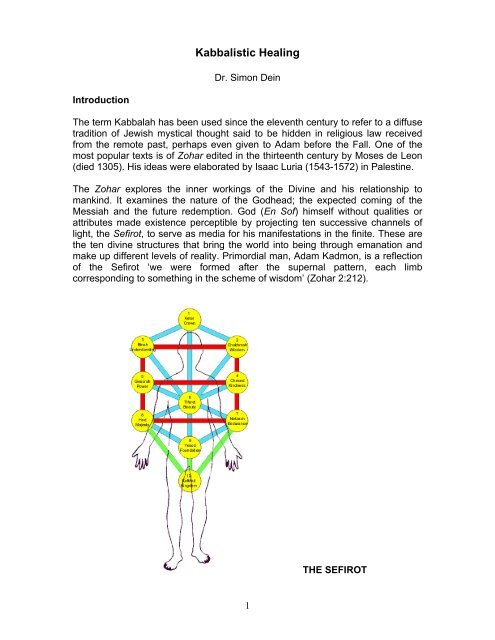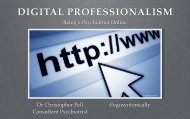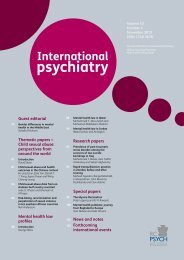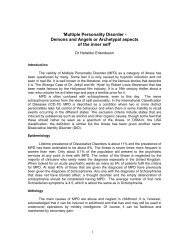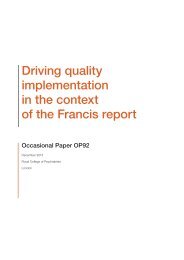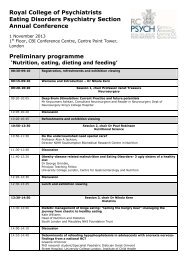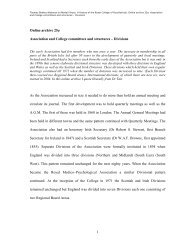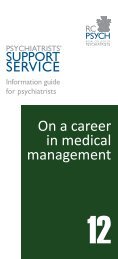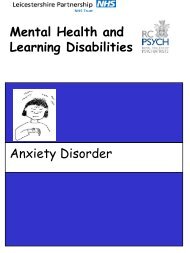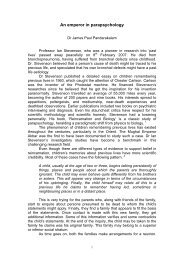Kabbalistic Healing
Kabbalistic Healing
Kabbalistic Healing
You also want an ePaper? Increase the reach of your titles
YUMPU automatically turns print PDFs into web optimized ePapers that Google loves.
Introduction<br />
<strong>Kabbalistic</strong> <strong>Healing</strong><br />
Dr. Simon Dein<br />
The term Kabbalah has been used since the eleventh century to refer to a diffuse<br />
tradition of Jewish mystical thought said to be hidden in religious law received<br />
from the remote past, perhaps even given to Adam before the Fall. One of the<br />
most popular texts is of Zohar edited in the thirteenth century by Moses de Leon<br />
(died 1305). His ideas were elaborated by Isaac Luria (1543-1572) in Palestine.<br />
The Zohar explores the inner workings of the Divine and his relationship to<br />
mankind. It examines the nature of the Godhead; the expected coming of the<br />
Messiah and the future redemption. God (En Sof) himself without qualities or<br />
attributes made existence perceptible by projecting ten successive channels of<br />
light, the Sefirot, to serve as media for his manifestations in the finite. These are<br />
the ten divine structures that bring the world into being through emanation and<br />
make up different levels of reality. Primordial man, Adam Kadmon, is a reflection<br />
of the Sefirot ‘we were formed after the supernal pattern, each limb<br />
corresponding to something in the scheme of wisdom’ (Zohar 2:212).<br />
1<br />
THE SEFIROT
According to Kabbalah, man and cosmos are inextricably linked. Disorder in the<br />
cosmos influences the physical, mental and spiritual health of mankind. By the<br />
performance of good deeds (mitzvot) cosmic disorder will be eliminated and so<br />
too physical and emotional suffering. Here I examine three aspects of Kabbalah<br />
and healing: psychoanalysis and Kabbalah; the healing ‘power’ of religious<br />
language in Hasidism and the contemporary revival of Kabbalah through the<br />
Kabbalah Centre.<br />
Psychoanalysis and Kabbalah<br />
David Bakan (1963) in Sigmund Freud and Jewish Mystical Tradition presents a<br />
cogent discussion of the relationship between psychoanalysis and Kabbalah. He<br />
argues that Freud consciously or unconsciously secularised Jewish mysticism;<br />
psychoanalysis can be viewed as a form of secularisation of Kabbalah. Although<br />
the influence of Kabbalah on Freud’s psychoanalytic writings is contentious, it<br />
does appear that Freud was exposed to <strong>Kabbalistic</strong> ideas early on in life (Dein<br />
2006).<br />
Freud’s methods, particularly free association, are similar to those developed by<br />
the early Kabbalists, especially the thirteenth century Spanish Kabbalist Rabbi<br />
Abraham Abulafia, who strove to ‘unseal the soul, to unite the knots which bind<br />
it,’ hence developing a theory of repression and a way of dealing with it six<br />
centuries before Freud. Abulafia described a form of free association he called<br />
‘skipping and jumping’ which involves according to Scholem (1955):<br />
‘a very remarkable method of using association as a way of mediation… a<br />
way of mediation… every jump opens a new sphere… within this sphere,<br />
the mind may freely associate, the jumping unites, therefore, elements are<br />
free and guided association and is said to ensure quite extraordinary<br />
results as far as the widening of the consciousness of the initiate<br />
concerned. The jumping brings to light hidden processes of the mind’.<br />
Like psychoanalysis, which attempts to reveal the hidden recesses of the mind,<br />
Kabbalah attempts to understand the hidden depth of Torah. The Torah can be<br />
read at different levels. The deepest level is the mystical level, which Kabbalah<br />
will help us to understand. Just as psychoanalysts attempt to delve into the<br />
subconscious, so too, Kabbalists attempt to delve and understand the deepest<br />
levels of the Torah.<br />
There are similarities between Kleinian thinking about ‘containment’ or ‘holding’<br />
and the <strong>Kabbalistic</strong> idea of shevirath ha-kelim, the breaking of the vessels.<br />
According the great Kabbalahist, Rabbi Isaac Luria, when God created the world<br />
he drew his light into a single point, a process which is referred to as tzimtsum. In<br />
a vacuum left by the original contraction light continued to pour in. It was<br />
necessary to contain this in a vessel. However, the vessel shattered resulting in<br />
shards or fragments containing seeds of the original light. The fragments with the<br />
embedded light are known as Klippot and are responsible for the existence of<br />
2
evil. The whole point of existence is to free the light trapped in the vessels, undo<br />
this exile and re-establish God’s unity.<br />
What is the relationship between this process and Melanie Klein’s ideas? For<br />
Klein, when a child is born, the unity between the child and his mother is broken.<br />
The child cannot contain the primary impulse which Klein recognises as both life<br />
impulse and death impulse (Freud’s Eros and Thanatos). For Klein the child<br />
needs to contain these impulses to protect himself from terrible internal tension.<br />
To do this he splits or shatters his mind and projects large parts of himself<br />
outwards into others. The outer world becomes full of bad persecuting bits and<br />
pieces. To deal with the emptiness he may take back or introject many of the bad<br />
bits.<br />
The <strong>Kabbalistic</strong> process of disintegration is repaired by establishing a relationship<br />
with God. In the same light, for Klein the child can be a functioning container of<br />
his own impulses and life forces by re-establishing a close relationship with those<br />
who love and care for him. A strong containing function is the requisite for order.<br />
Hasidism, Language and <strong>Healing</strong><br />
Hebrew Language in the Kabbalah has a metaphysical reality of its own. Words<br />
are more than descriptive, they are an integral part of the reality they describe.<br />
The letters mediate between the Sefirotic world and the material one. Language<br />
in the Kabbalah has a metaphysical reality of its own. Hasidim have incorporated<br />
<strong>Kabbalistic</strong> ideas into their religious texts.<br />
The Hasidim, or ‘pious ones’ in Hebrew, belong to a special movement within<br />
Orthodox Judaism, a movement that in the first half of the nineteenth century,<br />
claimed the allegiance of millions in Eastern and Central Europe - perhaps a<br />
majority of East European Jews. Lubavitch is a world wide movement of Hasidic<br />
Jews centred in New York where its leader, the seventh Lubavitcher Rebbe,<br />
resided until his death in June 1994. For the past twenty years I have been<br />
researching their understandings of healing (Dein 2002).<br />
The Lubavitch Rebbe<br />
3
The Lubavitch mystical text called Tanya is the philosophical work which<br />
emphasises a close the relationship between the Hebrew alphabet and the<br />
physical world: language is regarded as instrumental in the process of the<br />
creation of the world and is an actual component of reality. Lubavitchers<br />
maintain that the manipulation of the Hebrew language can bring about changes<br />
in the physical world − a form of <strong>Kabbalistic</strong> magic. Misspelling of a Hebrew word<br />
in a religious text can, so they hold, result in physical sickness. Repairing this<br />
aberration can result in physical healing.<br />
At times of sickness, Lubavitchers would typically write to their spiritual leader or<br />
Rebbe – Menachem Schneerson − for healing. He would respond by asking<br />
them to check their Mezuzot, a metal casing placed at the right hand doorposts of<br />
every room containing a parchment with Hebrew prayers written on them.<br />
Typically they would find some aberration in the writing on the parchment which<br />
reflects some disorder in their physical body. One such typical story:<br />
Mr Cohen, a 60 year old member of Lubavitch, developed angina due to<br />
blockage of his coronary arteries. Distressed by the pain which was not alleviated<br />
by medication, he wrote to the Lubavitch Rebbe. The Rebbe told him on three<br />
occasions to check his mezuzot. Finally, after sending the parchment to a scribe,<br />
it was found that the Hebrew word lev (heart) was scratched. Once the<br />
parchment was replaced his heart pain disappeared. Mr Cohen attributed his<br />
improvement in health to a close relationship between the Hebrew word lev<br />
(heart) and his physical heart.<br />
Contemporary Kabbalah : The Kabbalah Centre<br />
In the last twenty years, there has been a revival of interest in Kabbalah<br />
appealing largely to a secular audience. The Kabbalah Centre is a not-for-profit<br />
spiritual organisation with headquarters in Los Angeles that provides courses on<br />
Kabbalah on-line, and through its local centres. Its founder Philip Berg, and his<br />
wife Karen Berg, devised a unique and friendly user system accessible to anyone<br />
explaining <strong>Kabbalistic</strong> principles. Courses are open to Jews and non Jews. The<br />
Centre has attracted considerable opposition from Orthodox Jews who consider<br />
Berg’s teachings inauthentic and assert that mystical principles should only be<br />
taught to religious Jews.<br />
According to Berg, all widely held spiritual religious beliefs systems are merely<br />
specific branches of a universal wisdom. The Bible is not to be taken literally, but<br />
rather as a code and it can only be understood in this context. Kabbalah provides<br />
the means of understanding this code. The five senses provide access to a mere<br />
one percent of reality. By studying Kabbalah, one can understand the other 99%<br />
of reality, thus gaining knowledge of the ‘truth’. Berg emphasises the use of<br />
astrology to understand the nature of cosmic forces. Much of his teaching<br />
focuses on sexuality and the role of sexual union in the re-harmonisation of the<br />
universe (Berg 2006).<br />
4
The Kabbalah Centre has attracted a number of high profile followers such as<br />
Madonna and Lindsay Lohan, who maintain that <strong>Kabbalistic</strong> ideas have<br />
completely revolutionised their lives. The centre has attracted a lot of controversy<br />
on account of its claims of cures for cancer: spring water sold by the group was<br />
held to have amongst its effects a curative effect on cancer. Reputedly, bottles<br />
were sold to cancer suffers for hundreds of pounds. The Kabbalah Centre sells<br />
copies of its sacred texts such as the Zohar which are similarly held to possess<br />
healing powers. Among the best-selling items is the red string bracelet, said to<br />
protect the wearer from the ‘evil eye’.<br />
References<br />
Bakan D (1963) Sigmund Freud and the Jewish Mystical Tradition. New York:<br />
Schocken Books.<br />
Berg Y (2006). The Kabbalah Book of Sex: And Other Mysteries of the Universe.<br />
Kabbalah Publishing.<br />
Dein, S (2002) ‘The Power of Words: <strong>Healing</strong> narratives among Lubavitcher<br />
Hasidim’ Medical Anthropology Quarterly 16(1): 41-62<br />
Dein, S (2006) ‘The mystical roots of psychoanalytic theory’ World Cultural<br />
Psychiatry Research Review Jul/Oct: 133-137<br />
Scholem G (1955) Major Trends in Jewish Mysticism. London: Thames and<br />
Hudson<br />
© Simon Dein 2010<br />
5


